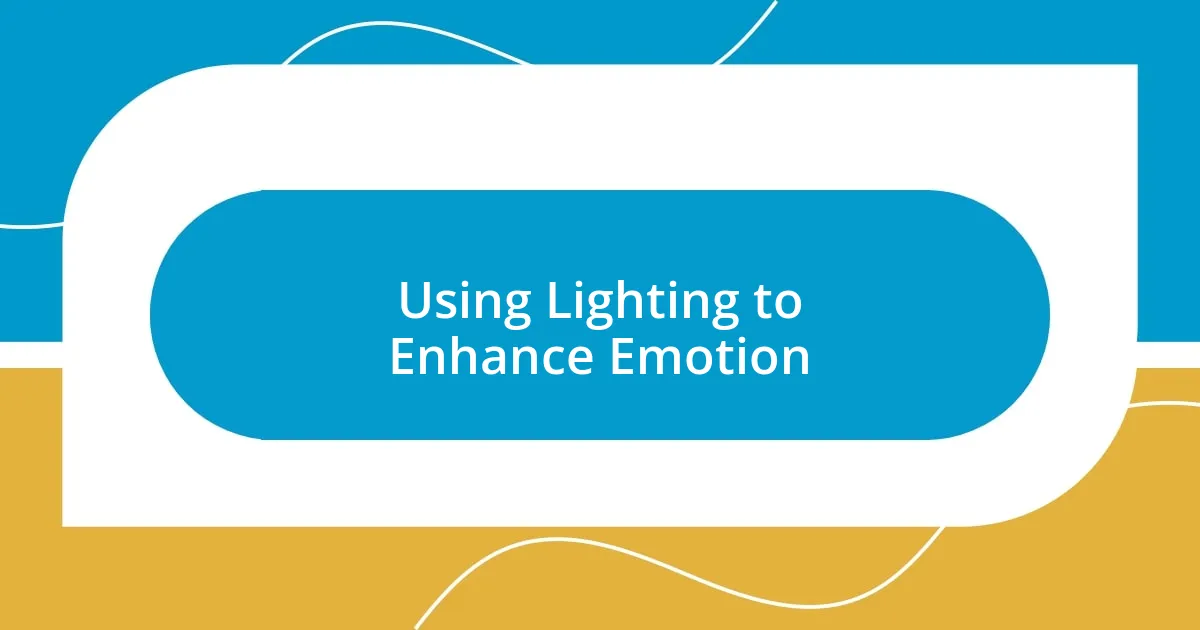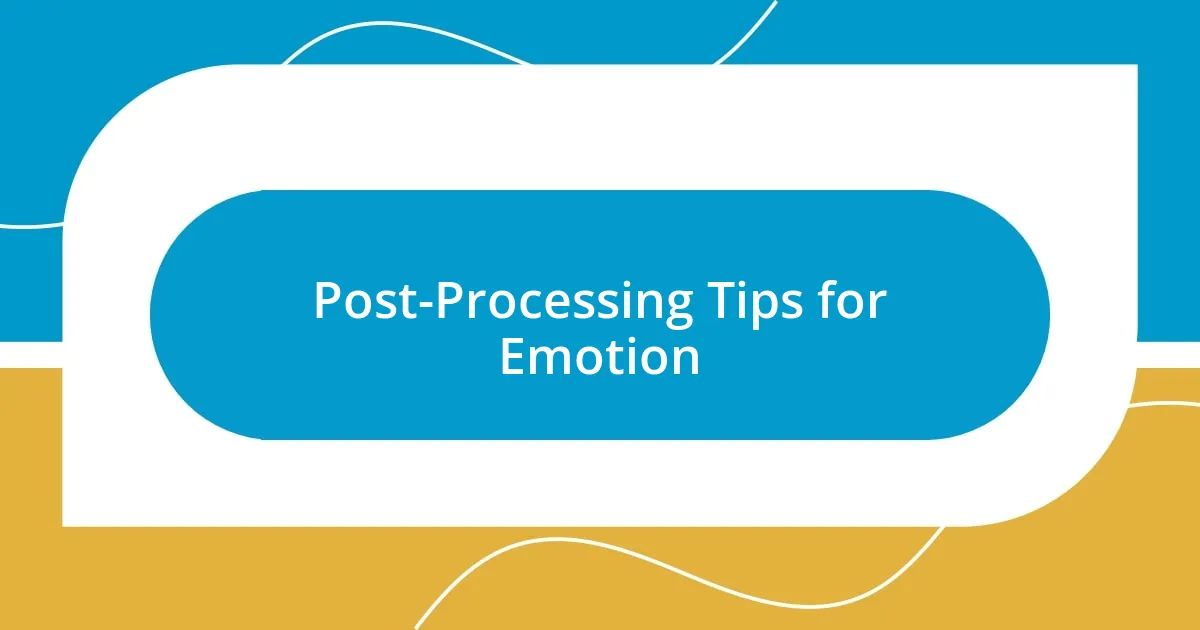Key takeaways:
- Emotional portraits are achieved through personal connection, trust, and creating a comfortable atmosphere for subjects.
- Techniques like active listening, reflective prompts, and physical cues enhance the authenticity of expressions.
- Lighting and post-processing techniques significantly impact the emotional tone of portraits, influencing viewer perception.
- Incorporating personal stories, gestures, and meaningful settings can transform a photograph into a compelling narrative.

Understanding Emotional Portraits
Understanding Emotional Portraits requires a keen ability to connect with your subject on a personal level. I remember a shoot where I asked my subject about her favorite childhood memory. The moment she began to speak, her eyes lit up, and I could see a wave of nostalgia wash over her. This was such a transformative moment that directly impacted the final image, allowing me to capture an expression that truly spoke to her inner joy.
It’s fascinating how subtlety can convey deep feelings in portraits. A slight tilt of the head or the position of the hands can tell a whole story. Have you ever noticed how someone’s gaze can shift from happiness to contemplation in an instant? I strive to create an atmosphere where my subjects can naturally express themselves. During one particular session, a simple prompt about a meaningful life experience revealed a vulnerability that turned into the most powerful shot. It reminded me that emotional portraits are about transcending the surface level.
Recognizing the importance of light and shadow also plays a crucial role in conveying emotion. I’ve often experimented with different lighting techniques to see how they affect the mood of the portrait. For instance, soft, diffused light can evoke a sense of calm and tenderness. Have you ever tried shooting during golden hour? That warm glow can evoke feelings of nostalgia and warmth, enhancing the emotional impact of your portrait tremendously. This interplay of light and emotion is something I continually explore, and it opens up a rich dialogue between photographer and subject.

Importance of Connection in Photography
Capturing emotion in photography hinges on building a connection with the subject. I once photographed a musician, and as we discussed her favorite song, I could see her passion ignite. By engaging in this conversation, I wasn’t merely taking photos; I was witnessing her story unfold. The resulting images radiated that energy, making the connection palpable.
Another aspect of connection is trust. I remember a time when I was shooting a stranger for a charity project. At first, he seemed reserved. When I shared a personal story about why the cause mattered to me, his demeanor shifted. He opened up, and those authentic expressions turned into the most heartfelt portraits. When subjects feel safe, they reveal parts of themselves that bring the image to life.
It’s also essential to recognize how the setting influences the emotional dialogue. During a photoshoot in a bustling city, I stepped away from the noise and found a quiet spot. The change in environment helped my subject relax, allowing her true emotions to surface. I’ve learned that the atmosphere you create affects both your subject’s comfort and the overall captured emotion.
| Aspect of Connection | Impact on Photography |
|---|---|
| Personal Interaction | Enhances emotional storytelling |
| Building Trust | Encourages vulnerability and authenticity |
| Environment | Affects comfort and emotional expression |

Techniques for Genuine Expressions
I’ve found that the choice of words during a shoot greatly influences the expressions that emerge. One technique I like to use is to incorporate light, playful banter, interspersed with meaningful questions. For instance, during a session with a young dancer, I joked about how she could perhaps teach me a few moves. It lightened the mood, and within moments, I captured a radiant, genuine grin that truly encapsulated her personality.
To enhance the authenticity of expressions, consider these techniques:
-
Active Listening: Pay close attention to your subject’s stories or feelings. This fosters a deeper bond, leading to more sincere expressions.
-
Reflective Prompts: Rather than generic questions, ask specific, reflective ones. This encourages your subject to dig deeper into their emotions, often resulting in more poignant expressions.
-
Physical Cues: Suggest small movements or adjustments in body language. A slight shift may unlock a new facet of their emotional state, making the moment feel more alive.
Each of these strategies not only enriches the emotional quality of the portrait but also allows your subjects to feel seen and heard.

Using Lighting to Enhance Emotion
Using lighting effectively can evoke a wide range of emotions in portrait photography. I recall a shoot where I used dramatic side lighting, casting deep shadows across my subject’s face. The resulting images felt intense and raw, highlighting not just their features but also the vulnerability behind their eyes. Isn’t it fascinating how a simple adjustment in light can shift the mood of an entire photograph?
Soft, natural light often evokes warmth and tenderness, making it a favorite of mine for capturing intimate moments. During an outdoor session at sunset, the golden hour created a halo effect around my subject. That illumination captured her serene expression beautifully, revealing a calmness that resonated with me. Can you see how enveloping a subject in gentle light can amplify feelings of peace and safety?
Conversely, I occasionally experiment with colored gels to express more abstract emotions. On one occasion, I bathed my subject in a deep blue light, which added a sense of melancholy to their portrait. It was incredible to witness how the color not only altered the scene but also drew out a reflective expression that matched the mood perfectly. How can one overlook the emotional power of color when it flows harmoniously with light?

Post-Processing Tips for Emotion
When editing portraits, I often play with contrast and saturation to amplify the mood I want to convey. For example, I remember a time when I lowered the contrast on a portrait of a close friend who had just experienced a loss. The softer tones communicated her vulnerability and added a sense of intimacy that I felt was essential to the moment. How do the adjustments you make in post-processing resonate with the emotions captured in the image?
I also find sharpening the eyes can draw viewers in and create an emotional connection. In one portrait session, I noticed that minor enhancements made her gaze feel more piercing and engaging. It’s almost like those eyes began to tell a deeper story. Isn’t it amazing how a subtle tweak can evoke such a strong feeling from the viewer?
Lastly, I sometimes use vignetting to direct focus where I want it. By dimming the edges of the frame, I’ve discovered that it can create a feeling of closeness or urgency in the composition. I once did this for a portrait of an elderly man, highlighting the wisdom in his eyes while grounding the viewer’s attention on his thoughtful expression. How can you use vignetting to not just frame, but enhance the emotional narrative of your photograph?

Telling a Story through Portraits
Capturing emotion in portraits is much like telling a story with a beginning, middle, and end. I remember a shoot where I asked my subject to think about a cherished memory. The moment her expression shifted from neutral to a soft smile, I clicked the shutter. That fleeting expression told a tale of love and nostalgia that words couldn’t quite capture. Isn’t it powerful how emotions can unfold in waves, revealing layers of human experience?
I often encourage my subjects to embody their stories through gestures or props. During a session with a dancer, she brought her favorite ballet shoes. As she delicately held them, her eyes reflected a blend of determination and longing. When I framed that moment, it felt as if the portrait was an invitation to explore her journey, each nuance whispering a different chapter. How do you think a personal touch can transform an image from a simple photograph to a profound narrative?
The background and setting also play a crucial role in storytelling. In one captivating session, I shot a young musician against the backdrop of a busy café. While people passed by, she was lost in her world, strumming her guitar. This contrast between her tranquility and the café’s hustle created a compelling narrative on finding one’s personal oasis. What stories do you believe can emerge when the environment supports the subject’s emotions?














